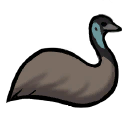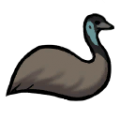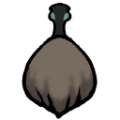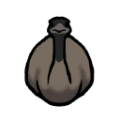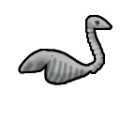Emu
Emu
A large flightless bird with beady eyes on its ugly face. With its bad attitude, it is the jerk of the natural world. Bother it, and it is guaranteed to seek revenge.
Base Stats
- Type
- Animal
- Flammability
- 70%
Pawn Stats
- Combat Power
- 70
- Move Speed
- 5.5 c/s
- Health Scale
- 90% HP
- Body Size
- 0.6
- Mass - Baby
- 3.6 kg
- Mass - Juvenile
- 18 kg
- Mass - Adult
- 36 kg
- Carrying Capacity
- 45 kg
- Filth Rate
- 8
- Hunger Rate
- 0.45 Nutrition/Day
- Diet
- herbivorous
- Life Expectancy
- 45 years
- Manhunter Chance
- 100%
- Manhunter Chance (Taming)
- 100%
- Trainable Intelligence
- None
- Wildness
- 95%
- Minimum Handling Skill
- 9
- Roam Interval
- 3 days
- Mate Interval
- 12 hours
- Maturity Age
- 0.222 years (13.3 days)
- Juvenile Age
- 0.1 years (6 days)
- Comfortable Temp Range
- -8 °C – 50 °C (17.6 °F – 122 °F)
Production
- Meat Yield
- 84
 bird meat
bird meat - Leather Yield
- 28
 birdskin
birdskin - Eggs Per Clutch
- 1 to 1
- Egg Laying Interval
- 3.33 days
- Can Lay Unfertilized Eggs
- false
Melee Combat
- Attack 1
- Feet
8 dmg (Scratch)
12 % AP
1.5 second cooldown
Stun for 280 ticks (4.67 secs) on first strike - Attack 3
- Head
6 dmg (Blunt)
9 % AP
2 second cooldown
0.2 chance factor - Average DPS
- 2.65
- tradeTags
- AnimalUncommon
The Emu is a large, flightless and incredibly aggressive bird found in arid shrublands and deserts.
Taming
Emu can be tamed wild, randomly join your colony in an event, or bought pre-tamed from a trading ship. Emus will always turn manhunter on a failed tame attempt.
Summary
Emus are pen animals. Once tamed, pen animals cannot and do not need to be trained any further. But if left outside of a pen or caravan hitching spot, pen animals will eventually roam outside your colony. Making a caravan is not required to tie animals to a caravan hitching spot.
A female emu produces 1 emu egg every 3.33 day when fertilized. Emus will not lay unfertilized eggs.
Analysis
Emus are one of many egg-laying animals that are inferior to chickens. 2 hens eat less food than 1 emu, and each hen lays 3.33 eggs for every emu egg. While an emu egg is worth 2 chicken eggs, a single hen remains superior for egg production, let alone 2. Hens do not need to be fertilized, which adds a further advantage.
While chickens cannot be found in the wild, the dromedary is superior to the emu. They can be found in all biomes emu reside in. Dromedaries produce more food (in the form of milk), both per day and per nutrition fed. They are easier to tame, won't go manhunter on a failed tame, and can be ridden on a caravan. So if dromedaries are available, there's little point in keeping an emu pet.
Therefore, emus are mostly relegated to hunting fodder, the occasional manhunter pack, and to add a little ambiance to the desert biomes.
Training
This animal can be trained as follows:
| Guard: | |
|---|---|
| Attack: | |
| Rescue: | |
| Haul: | |
*As of version 1.1.2610, all animals can be tamed. The percentage of likelihood of success depends on factors such as the Animals Wildness Percentage, Pawn Handling Skill, and others. More information can be found on the animals page.
Health
| Part Name | Health | Quantity | Coverage[1] | Target Chance[2] | Subpart of | Internal | Capacity[3] | Effect if Destroyed/Removed |
|---|---|---|---|---|---|---|---|---|
| Body | 36 | 1 | 100% | 19% | N/A[4] | - | Death | |
| Tail | 9 | 1 | 10% | 10% | Body | - | - | |
| Spine | 22.5 | 1 | 5% | 5% | Body | Moving |
−100% Moving[5] | |
| Stomach | 18 | 1 | 4% | 4% | Body | Digestion |
−50% Digestion | |
| Heart | 13.5 | 1 | 3% | 3% | Body | Blood Pumping |
Death | |
| Lung | 13.5 | 2 | 4% | 4% | Body | Breathing |
−50% Breathing. Death if both lost. | |
| Kidney | 13.5 | 2 | 3% | 3% | Body | Blood Filtration | −50% Blood Filtration. Death if both lost. | |
| Liver | 18 | 1 | 5% | 5% | Body | Digestion |
−50% Digestion | |
| Neck | 22.5 | 1 | 20% | 5% | Body | Eating Talking Breathing |
Death | |
| Head | 22.5 | 1 | 75% | 3.1% | Neck | - | Death | |
| Skull | 22.5 | 1 | 30% | 1.8% | Head | - | Cannot be destroyed. Increasing Pain based on damage. | |
| Brain | 9 | 1 | 60% | 2.7% | Skull | Consciousness |
Death Damage always results in scarring. | |
| Eye | 9 | 2 | 12% | 1.8% | Head | Sight |
−25% Sight. −100% if both lost. Damage always results in scarring. 0% Hit Chance against Blunt damage. | |
| Beak | 18 | 1 | 25% | 3.8% | Head | Eating Talking Manipulation |
−100% Manipulation −90% Eating[6] | |
| Leg | 27 | 2 | 10% | 5% | Body | Moving |
−50% Moving. −100% if both lost. | |
| Foot | 22.5 | 2 | 50% | 5% | Leg | Moving |
−50% Moving. −100% if both lost. |
- ↑ Coverage determines the chance to hit this body part. It refers to the percentage of the super-part that this part covers, before its own sub-parts claim their own percentage. For example, if the base coverage of the super-part is 100%, and the coverage of the part is 20%, 20% of hits would hit the part, and 80% the super-part. If the part had its own sub-part with 50% coverage, the chances would be 10% sub-part, 10% part, 80% super part.
- ↑ Target Chance is the actual chance for each part to be be selected as the target when each part's coverage has been taken into account(I.E. Neck covers 7.5% of Torso but Head covers 80% of Neck so it actually has only a 1.5% chance to be selected). This is not pure hit chance, as different damage types propagate damage in different ways. See that page for details.
- ↑ Note that capacities can affect other capacities in turn. Only the primary effect is listed. See specific pages for details.
- ↑ This is the part that everything else connects to to be considered 'connected'.
- ↑ If Moving drops below 16% a pawn cannot move.
- ↑ Note that eating won't go below 10%.
